|
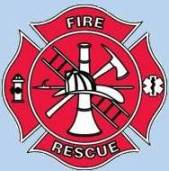
|
FIRE PREVENTION BULLETIN
Calling in an Emergency
9-1-1
|
|
|
|
What is 9-1-1?
Nine-one-one is the number to call to get help in a police, fire or
medical emergency. A 9-1-1 call is transmitted over dedicated phone
lines to the emergency agency (police, fire, sheriff) assigned to the
city or area you are calling from. Trained dispatchers then send
emergency help as needed.
|
|
|
What does 9-1-1 do?
A nine-one-one call will automatically dispatch you to a trained
professional who will answer your call, ask you to describe your
emergency situation and route the necessary emergency personnel
to your location to assist you.

|
|
|
When should I call 9-1-1?
1. 9-1-1 is for people emergencies only
2. It should NEVER be use as a joke or prank
3. You should call 9-1-1 when there is a serious "people" emergency
4. When there is a REAL need for one of the following:
 o There is a crime and you need the POLICE
o There is a crime and you need the POLICE
 o There is a fire and you need FIREFIGHTERS
o There is a fire and you need FIREFIGHTERS
 o Someone is seriously injured or unconscious and you need an AMBULANCE & EMERGENCY MEDICAL RESPONSE
o Someone is seriously injured or unconscious and you need an AMBULANCE & EMERGENCY MEDICAL RESPONSE
5. Watch the video section: 9-1-1 Quiz Show listed below to learn about specific situations
|
|
|

How do I dial 9-1-1?
1. On a landline phone or pay telephone:
xx
• What is a landline phone:
 o Landline phones come in many different styles.
o Landline phones come in many different styles.
 o The one thing that they have in common is that they must be plugged into a phone
jack to operate.
o The one thing that they have in common is that they must be plugged into a phone
jack to operate.
 o Most landline phones are push button, however older phones have dial pads.
o Most landline phones are push button, however older phones have dial pads.
 o In addition there are many portable phones which may look a lot like a wireless
phone.
o In addition there are many portable phones which may look a lot like a wireless
phone.
 o Why don’t you identify all the phones your family use and know if they are a
landline phone or a wireless phone.
o Why don’t you identify all the phones your family use and know if they are a
landline phone or a wireless phone.
xx
• What about pay phones?
 o Pay phones are located in public places and have push buttons. Older ones have a
dial.
o Pay phones are located in public places and have push buttons. Older ones have a
dial.
xx
• How to Dial:
 o Stay calm
o Stay calm
 o Make sure your know the exact location and address of the emergency
o Make sure your know the exact location and address of the emergency
 o Pick up the receiver or turn on the phone and wait for the DIAL TONE
o Pick up the receiver or turn on the phone and wait for the DIAL TONE
 o Dial or press “9”, then”1” and then “1” again.
o Dial or press “9”, then”1” and then “1” again.
 o Wait for the ring and the 9-1-1 Dispatcher will answer
o Wait for the ring and the 9-1-1 Dispatcher will answer
2. On a wireless phone:
 o Some of the other names people use for a wireless phone is cellular, mobile,
or car phone
o Some of the other names people use for a wireless phone is cellular, mobile,
or car phone
 o Remember a wireless phone is not the same as a portable phone you might have at home
o Remember a wireless phone is not the same as a portable phone you might have at home
 o There are many different types of wireless phones
o There are many different types of wireless phones
3. Never practice calling 9-1-1 on a real phone
4. Remember you don’t need any money to call 9-1-1 on any pay phone.
|
|
|
What do I say?
1. Stay calm, speak clearly and be prepared to give as much
information as possible regarding the emergency when the
xxDispatcher asks you.
2. Listen carefully to the Dispatchers questions and answer each question carefully.
3. Remember the Dispatcher cannot see your hand or head gestures, signs or motions.
So verbally answer all questions.
4. The Dispatcher can only hear you, so answer all questions verbally.
5. Do not hang up until the Dispatcher tells you it is OK to do so.
6. Follow the instructions of the Dispatcher.
7. Remember remain calm and follow Dispatcher’s instructions.
|
|
|
Basic Safety Tips

EMERGENCIES
In an emergency, call 9-1-1, stay calm, and make sure everyone is
safe until help comes.
|
|
|

FIRE
Get out of the building if you can.
Set off the fire alarms.
Close doors and windows to slow down the fire.
If you are trapped inside, stay near the floor.
Go to a window and call for help.
To use a fire extinguisher, think PASS:
Pull the pin.
Aim the nozzle at the base of the fire.
Squeeze the handle.
Sweep foam from side to side.
|
|
|

POWER OUTAGE
Turn off all appliances and computers.
Leave one light on, to show when power is back on.
Do not use candles. Use flashlights.
When power is on again, make sure that appliances work properly.
If you are cold, bring everyone into one room and close all doors to
keep heat in.
Drivers: If traffic signals are not working, treat them as stop signs.
|
|
|

POISONING
If you suspect poisoning, call 9-1-1 immediately.
If you know what poison was taken, tell the operator.
Keep the victim safe and warm until help arrives.
|
|
|

IF SOMEONE IS INJURED
Do not move the victim unless there is immediate danger.
Call 9-1-1. If the victim is bleeding or unconscious, tell the operator.
Remain calm. Stay with the victim.
If the victim is bleeding:
Apply direct pressure to the wound. Raise the injured area.
Do not let the victim’s blood touch your skin.
|
Back to top
|

|
|
Carbon monoxide (CO) is a deadly gas that is difficult to detect because
it is odorless and invisible. As a result, it is known as “the silent killer.”
According to the U.S. Consumer Product Safety Commission (CPSC), this
poisonous gas kills nearly 300 people in their homes each year.
CO is produced by fuel-burning appliances and equipment in our homes. If
you have heating, cooking or power equipment that uses fuels such as oil,
natural gas, coal, wood, propane, gasoline, etc., then your home is at risk
for potential CO poisoning. Homes with attached garages are also at risk,
because vehicles left running in the garage can cause CO to seep into the home.
CO poisoning can be prevented by proper care and use of household equipment.
CO alarms can provide early detection if CO leaks or accumulation occurs.
Both are important for your safety.
|
|
|

|
|
• If you suspect CO poisoning in your home, call the appropriate
responding agency, usually your local fire department or 9-1-1.
Keep all emergency response numbers posted by every telephone.
|
|
|

|
|
• CO alarms are different from smoke alarms, and have different functions.
CO alarms do not provide early warning of a fire. Smoke alarms do not
provide early warning of CO exposure. Your home needs both CO and smoke
alarm protection.
|
|
|
Symptoms of CO poisoning are similar to symptoms of the flu, and can include
headache, dizziness, nausea and shortness of breath. If your CO alarm sounds
check to see if it is plugged in properly, or if battery-powered, check the
battery to be sure the device is operating. If you suspect that CO is leaking
in your home, follow these steps:
|
|
|
|

|
|
• Open windows and doors to ventilate the rooms, or in severe cases of CO exposure,
evacuate the home.
|
|
|

|
|
• Call to report that you suspect CO is accumulating. Usually the appropriate
agency to call is the fire department
or 9-1-1.
|
|
|

|
|
• Seek immediate medical treatment for anyone who has severe symptoms.
|
|
|

|
|
• Follow the advice of the responding agency before re-entering your home, and
quickly obtain repairs as needed.
|
Back to top
|

|
|
The Home Safety Council recommends the following to avoid
CO poisoning in your home:
|
|
|

|
|
• Purchase CO alarms that are listed by Underwriters Laboratories (UL). Install
at least one CO alarm in your home, near the sleeping areas. A hallway outside
bedrooms, for example.
|
|
|

|
|
• Use appliances and equipment according to directions and only for the purposes,
they are intended. For example, use a range or cook stove only for cooking,
never to heat your home.
|
|
|
For additional safety from CO exposure:
|
|
|

|
|
• Never use a barbecue or gas grill indoors, inside a garage or in an enclosed
porch.
|
|
|
• Electric generators must never be used inside the home or garage, or in any
enclosed area.
• Back vehicles out of the garage when warming up the engine.
• Have a trained professional inspect, clean and tune-up your central
heating system before the heating season each year.
• Have a professional sweep inspect your chimneys once a year and clean
them if needed.
|
|
|

|
|
• If you have a wood stove, verify that it meets local fire codes. Contact
your town’s fire marshal if you have questions.
• When purchasing a new wood stove or portable space heater, choose equipment
that is UL-listed.
|
|
|

|
|
• Open flues before using fireplaces.
|
|
|
• Be aware that kerosene heaters are illegal in some areas.
• Re-fuel kerosene heaters outdoors only, after the device has cooled.
• Kerosene and gas heaters should always be used with ventilation (such
as an open window).
|
|
|
Purchasing a new home? Before you sign the contract, have the home
inspected to ensure fuel-burning heating and cooking equipment is safe
to use, including fireplaces, wood stoves and chimneys.
|
Back to top
|

|
FIRE PREVENTION BULLETIN
Fire Extinguisher Safety
|
|
|
|
There are basically four different types or classes of fire extinguishers, each
of which extinguishes specific types of fire. Newer fire extinguishers use a
picture/labeling system to designate which types of fires they are to be used on.
Older fire extinguishers are labeled with colored geometrical shapes with letter
designations. Both of these types of labels are shown below with the description
of the different classes of extinguishers.
Additionally, Class A and Class B fire extinguishers have a numerical rating which
is based on tests conducted by Underwriter’s Laboratories that are designed to
determine the extinguishing potential for each size and type of extinguisher. Click
on any of the topics listed below for additional information that may be helpful to know.
|
|
Fire Extinguisher Ratings
|
|



.
|
Class A Extinguishers will put out fires in ordinary combustibles, such as wood and
paper. The numerical rating for this class of fire extinguisher refers to the amount of
water the fire extinguisher holds and the amount of fire it will extinguish.
Class B Extinguishers should be used on fires involving flammable liquids, such as grease,
gasoline, oil, etc. The numerical rating for this class of fire extinguisher states the
approximate number of square feet of a flammable liquid fire that a non-expert person
can expect to extinguish.
Class C Extinguishers are suitable for use on electrically energized fires. This class of
fire extinguishers does not have a numerical rating. The presence of the letter “C”
indicates that the extinguishing agent is non-conductive.
Class D Extinguishers are designed for use on flammable metals and are often specific for
the type of metal in question. There is no picture designator for Class D extinguishers.
These extinguishers generally have no rating nor are they given a multi-purpose rating for
use on other types of fires.
|




|
|
Multi-Class Ratings
|
|

|
Many extinguishers available today can be used on different types of fires and will
be labeled with more than one designator, e.g. A-B, B-C, or A-B-C. Make sure that if
you have a multi-purpose extinguisher it is properly labeled.
|
|
This is the old style of labeling, indicating suitability for use on Class A, B,
and C fires.
|

|
|
|

|
This is the new style of labeling that shows this extinguisher may be used on Ordinary
Combustibles, Flammable Liquids, or Electrical Equipment fires. This is the new labeling
style with a diagonal red line drawn through the picture to indicate what type of fire
this extinguisher is NOT suitable for. In this example, the fire extinguisher could be
used on Ordinary Combustibles and Flammable Liquids fires, but not for Electrical
Equipment fires.
|
|
Types of Fire Extinguishers
|
|




.
|
Dry Chemical extinguishers are usually rated for multiple purpose use. They contain an
extinguishing agent and use a compressed, non-flammable gas as a propellant.
Halon extinguishers contain a gas that interrupts the chemical reaction that takes
place when fuels burn. These types of extinguishers are often used to protect valuable
electrical equipment since they leave no residue to clean up. Halon extinguishers have a
limited range, usually 4 to 6 feet. The initial application of Halon should be made at
the base of the fire, even after the flames have been extinguished.
Water These extinguishers contain water and compressed gas, and should only be used on Class A
(ordinary combustibles) fires.
Carbon Dioxide (CO2) extinguishers are most effective on Class B and C (liquids and
electrical) fires. Since the gas disperses quickly, these extinguishers are only effective
from 3 to 8 feet. The carbon dioxide is stored as a compressed liquid in the extinguisher;
as it expands, it cools the surrounding air. The cooling will often cause ice to form
around the “horn” where the gas is expelled from the extinguisher. Since the fire could
re-ignite, continue to apply the agent even after the fire appears to be out.
|
|
How to Use a Fire Extinguisher
|
|
Even though extinguishers come in a number of shapes and sizes, they all operate in a
similar manner. Here's an easy acronym for fire extinguisher use:
 P A S S - Pull, Aim, Squeeze, Sweep
P A S S - Pull, Aim, Squeeze, Sweep
|
|




.
|
Pull the pin at the top of the extinguisher that keeps the handle from
being accidentally pressed.
Aim the nozzle toward the base of the fire.
Stand approximately 8 feet away from the fire and squeeze the handle to discharge the
extinguisher. If you release the handle, the discharge will stop.
Sweep the nozzle back and forth at the base of the fire. After
the fire appears to be out, watch it carefully since it may re-ignite!
Congratulations -- you did it!!!
|
|
Back to top
|

|
FIRE PREVENTION BULLETIN
Home Heating Safety
|
|
|
|
Heating equipment, especially portable and space heaters, fireplaces and wood stoves,
require careful use and proper maintenance. Home Safety Council offers the following tips
to help families prevent fire- and burn-related injuries during the winter months.
|
|
Portable Space Heaters
|
|
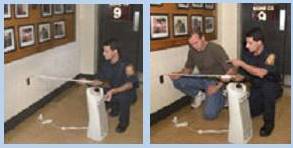
|
|
Purchase electric space heaters that bear the mark of an independent
testing laboratory, such as UL, ETL, CSA, etc.
Place space heaters at least three feet away from anything that
can burn - including furniture, people, pets and window treatments.
Turn off space heaters before leaving a room or going to sleep.
Supervise children and pets at all times when a portable space
heater is in use.
Use kerosene heaters only where permitted by law. Use the
recommended grade kerosene and never use an alternative fuel. Kerosene heaters must be
fueled outside.
Never use space heaters to dry clothing or blankets.
|
|
Fireplaces and Wood Stoves
|
|

|
|
Burn only seasoned hardwood - not trash, cardboard boxes, or Christmas
trees because these items burn unevenly, may contain toxins, and increase the risk of
uncontrolled fires.
Have a professional chimney sweep inspect chimneys annually for cracks,
blockages and leaks. Have them cleaned and repaired as needed.
Keep all persons, pets and flammable objects, including kindling, bedding,
clothing, at least three feet away from fireplaces and wood stoves.
Open flues before fireplaces are used.
Use sturdy screens or doors to keep embers inside fireplaces.
Install at least one smoke alarm on every level of your home and inside
or near sleeping areas.
Keep young children away from working wood stoves and heaters to avoid
contact burn injuries.
|
|
Carbon Monoxide (CO) Poisoning Precautions
|
|
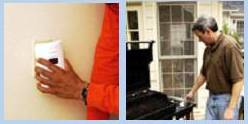
|
|
Carbon monoxide is commonly known as “the silent killer.” Because it is colorless,
odorless, and tasteless, none of your senses can detect it. CO claims the lives of
nearly 300 people in their homes each year according to the U.S. Consumer Product
Safety Commission (CPSC). CO is a potentially deadly gas that is produced by fuel-burning
heating equipment, such as furnaces, wood stoves, fireplaces, and kerosene heaters.
Follow these guidelines to help keep your family safer.
|
|
Install at least one CO alarm near sleeping areas.
Have a trained professional inspect, clean and tune-up your home’s
central heating system and repair leaks or other problems; fireplaces and woodstoves
should also be inspected each year and cleaned or repaired as needed.
Keep gas appliances properly adjusted and serviced.
Never use an oven or range to heat your home.
Never use a gas or charcoal grill inside your home or in a closed garage.
Portable electric generators must be used outside only. Never use
them indoors, in a garage or in any confined area that can allow CO to collect. Follow
usage directions closely.
|
Back to top
|

|
FIRE PREVENTION BULLETIN
Learn about E.D.I.T.H.
Exit Drills in the Home
|
|
|
EXIT DRILLS IN YOUR HOME:
In 1995, 3640 American died in home fires. That’s roughly 10 people a day. Tens of thousands
more were injured. People can survive major fires in their homes if they if they are alerted
to the fire, and get out quickly and stay out.
HOW TO SURVIVE:
Install smoke detectors and keep them in working order.
Make an escape plan and “practice” it.
Consider installing an automatic fire-sprinkler system.
PLAN YOUR ESCAPE:
Once the fire has started, there is no time to plan how to get out. Sit down with your
family today, and make a step-by-step plan for escaping a fire.
Draw a floor plan of your home, making two ways out of every room-especially sleeping
areas. Discuss the escape routes with every member of your household.
Agree on a meeting place, where every member of the household will gather outside your
home after escaping a fire to wait for the fire department. This allows you to count heads
and inform the fire department if anyone is missing or trapped inside the burning building.
Practice your escape plan, at least twice a year. Have a fire drill in your home.
Appoint someone to be the monitor, and have everyone participate. A fire drill is not a race,
Get out quickly, but carefully.
MAKE YOUR EXIT DRILL REALISTIC:
Pretend that some exits are blocked by fire, and practice alternative escape routes. Pretend
that the lights are out and that some escapes routes are filling up with smoke.
BE PREPARED:
Make sure everyone in the household can unlock all doors and windows quickly, even in the
dark. Window or doors with security bars need to be equipped with quick release devices,
and everyone in the household should know how to use them.
If you live in an apartment building, use stairways to escape. NEVER use an elevator
during a fire. It may stop between floors or take you to a floor where the fire is burning.
Some high-rise buildings may have evacuation plans that require you to stay where you are
and wait for the fire department.
If you live in a multi-story house, and you must escape from an upper story window,
be sure there is a safe way to reach the ground, such as a fire-resistant fire escape ladder.
Make sure special arrangements are made for children, older people and people with disabilities.
People who have difficulty moving should have a phone in their sleeping area and, if possible
should sleep on the ground floor.
Test doors before opening them:
While kneeling or crouching at the door, reach up as high as you can and with the back of
your hand touch the door, the knob, and the crack between the door and its frame, if you
feel any warmth at all, use another escape route. If the door feels cool, open it with
caution. Put your shoulder against the door and open it slowly. Be prepared to slam it shut
if there is smoke or flames on the other side.
If you are trapped, close all doors between you and the fire, stuff the cracks around
the doors to keep out smoke. Wait at a window and signal for help with a flashlight or by
waving a light colored cloth. If there a phone in the room, call 9-1-1 and report exactly
where you are.
GET OUT FAST….
In case of a fire, don’t stop for anything. Do not try to rescue possessions or pets. Go
directly to your meeting place, and then call 9-1-1 from a neighbor’s phone, or a portable phone.
Every member of your household should know how to call the Fire Department.
Crawl low under the smoke:
Smoke contains deadly gases, and heat rises. During a fire, cleaner air will be near the
floor. If you encounter smoke when using the primary exit, use an alternative escape route.
If you must exit through the smoke, crawl on your hands and knees, keeping your head 12 to 14
inches above the floor.
…. and stay out:
Once you are out of your house, don’t go back for any reason. If people are trapped, the
firefighters have the best chance of rescuing them. The heat and smoke of a fire are
overpowering. Firefighters have the training, experience, and protective equipment needed to
enter a burning building.
PLAY IT SAFE:
Smoke Detectors, More than half of fatal home fires happen at night while people are
asleep. Smoke detectors sound an alarm when the fire starts, waking people before they are
trapped or overcome by smoke. With smoke detectors, your risk of dying in a home fire is cut
nearly in half. Install smoke detectors outside every sleeping area and on every level of
your home, including the basement. Follow installation instructions carefully, and test smoke
detectors monthly. Change all smoke detector batteries at lease once a year. If your smoke
detector is more then 10 years old replace it with a new one.
Now, use what you have learned, SET UP YOUR PLAN, including two ways out, a meeting place
and CONDUCT A PRACTICE DRILL to determine if anything has been overlooked. EVERYONE in the
household NEEDS TO PARTICIPATE for it to be successful. It may SAVE YOUR LIFE.
Back to top
|
|

|
FIRE PREVENTION BULLETIN
Smoke Detectors
|
|
You can prevent tragedies simply by testing and maintaining your smoke alarms and practicing
a fire escape plan. All smoke alarms in your house should be tested once a month, and their
batteries replaced annually. Every family should develop a fire escape plan and practice it
at least twice a year. The U.S. Consumer Product Safety Commission (CPSC) recommends these
measures because working smoke alarms and a fire escape plan will increase your protection
in case of a fire.
Every year in the United States, about 3,000 people lose their lives in residential fires.
Most fire victims die from inhalation of smoke and toxic gases, not as a result of burns.
Most deaths and injuries occur in fires that happen at night while the victims are asleep.
Properly installed and maintained smoke alarms in the home are considered one of the best and
least expensive means of providing an early warning of a potentially deadly fire. Smoke
alarms save lives, prevent injuries, and minimize property damage by enabling residents to
detect fires early in their development. The risk of dying from fires in homes without
smoke alarms is twice as high as in homes that have working smoke alarms.
All smoke alarms should be tested at least once a month to make sure they operate properly.
If a smoke alarm is battery operated, replace the batteries at least once a year to make
sure the alarm will work when it is needed. It’s a good practice to make replacement of
batteries a seasonal routine, such as when resetting clocks in the fall or spring. Always
follow the manufacturer's instructions for testing smoke alarms and replacing the batteries.
If your battery-powered smoke alarm begins to emit a low-power warning, usually a chirping
sound, replace the battery immediately with a fresh one. This will ensure that your smoke
alarm will continue to provide protection.
|
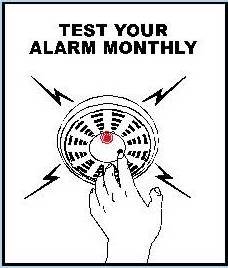
Follow Manufacturer's Instructions
|
|
Never disable your smoke alarm, even if you experience "nuisance" alarms while cooking or
showering. Clean the smoke alarm following the manufacturer's instructions, and if possible
relocate it away from the kitchen or bathroom. If nuisance alarms are a persistent problem,
you may need to look for a different type of smoke alarm. A photoelectric smoke alarm is less
sensitive to common causes of false alarms. Some smoke alarms have a silencing feature, so
nuisance alarms can be stopped quickly and easily.
At the same time you replace your smoke alarm batteries, replace the batteries in your Carbon
Monoxide (CO) alarm. CO is a colorless, odorless gas that is produced when any fuel is
incompletely burned. About 150 people die each year from non-fire, carbon monoxide poisoning
associated with home fuel-burning heating equipment. For more information on CO, see CPSC
Publication #466.
|
|
Children Sleeping Through Smoke Alarms
Recent information from broadcast news programs demonstrated that children can sleep right
through the sound of a smoke alarm.
While smoke alarms have proven to be effective
lifesavers, CPSC is concerned that children can sleep right through the sound of a smoke
alarm and that the elderly, many of whom live alone, may not hear an alarm.
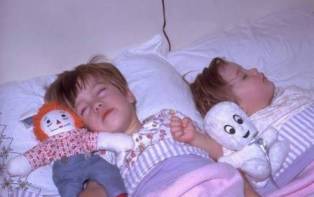
CPSC has already begun a two-year project on the Sound Effectiveness of Smoke Alarms. CPSC’s
study will look into why children and older adults sleep through or do not hear the sound of a
smoke alarm and whether new technologies can improve the effectiveness of smoke alarms. Our
research hopes to find ways to assure that all consumers can hear the alarm quickly enough to
begin their escape from danger.
Because children, older people, and those with special
needs may not wake up to the sound of a smoke alarm, parents and caregivers must incorporate
this possibility into the home fire escape plan.
When practicing your home fire escape
plan, make sure all escape routes are clear. Correct such problems as blocked exits, jammed
locks or barred windows.
CPSC recommends the following on smoke alarms:
Install a working smoke alarm on every level of the home, outside sleeping
areas, and inside bedrooms.
Test your smoke alarms at least once a month.
Replace smoke alarm batteries at least annually, such as when resetting clocks
in the fall or spring.
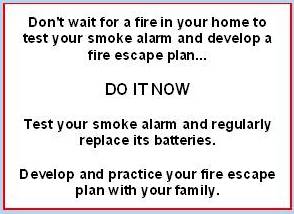
|
|
At least one smoke alarm should be placed on every level of the home. The most important
location is near the bedrooms to provide an early warning to all sleeping occupants. A smoke
alarm should also be placed inside every bedroom. Follow the manufacturer's instructions on how
to properly install a smoke alarm.
CPSC also urges consumers to develop and rehearse an
escape plan so that when the smoke alarm sounds, family members will immediately move to a safe
location outside the home.
CPSC recommends the following on fire escape planning:
Every family should develop a home fire escape plan and practice it at least
twice a year with the entire household.
Practice the fire escape plan with your children, baby-sitter, and older family
members.
During practice, it is important to be aware of and remove obstacles that may
prevent a quick and safe evacuation, such as blocked exits or jammed or barred windows.
Children may not awaken from the sound of a smoke alarm. Parents should hold a
fire drill during the night so they can assess their children’s ability to awaken and respond appropriately.
If children, or any other family member, cannot awaken to or hear the smoke
alarm, the escape plan should be adjusted accordingly to help get all family members out
safely.
 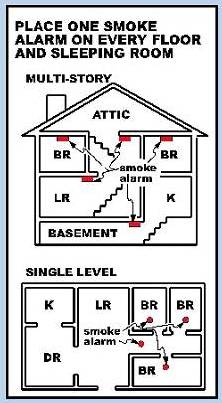
Make sure alarms are placed either on the ceiling or 6-12 inches below the ceiling on the
wall. Locate smoke alarms away from air vents or registers; high air flow or dead air spaces
are to be avoided. Dead air spaces are often at the top of a peaked roof, or in corners
between ceilings and walls.
|
Back to top
|

|
FIRE PREVENTION BULLETIN
Stop, Drop and Roll
|
|
All too often, people are badly burned when their clothes catch fire. Sometimes the burns
are made worse when people run to get water or someone to help. Fires need air (oxygen) to
burn. If your clothes catch fire and you run, you are feeding the fire and it will burn hotter
and faster.
Teach your children and every member of your family the "Stop, Drop and Roll" safety lesson.
Here are the basic steps:
STOP where you are. Don’t run as this will only make the fire worse.
DROP to your knees and then to the ground.
ROLL over and over or from side to side, covering your eyes, nose, and mouth with your
hands, if possible, rolling until you’re sure the fire is out. This will help smother the
flames.
Practice "Stop, Drop, and Roll." Practicing makes the actual response more of an immediate
reaction that requires less thinking time during an actual emergency situation. To make it
more realistic, practice the procedure in a room with furniture, which would make it necessary
to roll or rock back and forth, instead of over and over.
Children have a tendency to confuse this message with messages about escaping from a fire.
Make sure they understand that "Stop, Drop, and Roll" is to be used only when clothing catches
on fire. Once the flames are out, cool the burned skin with water for 10 to 15 minutes and get
medical attention.
|
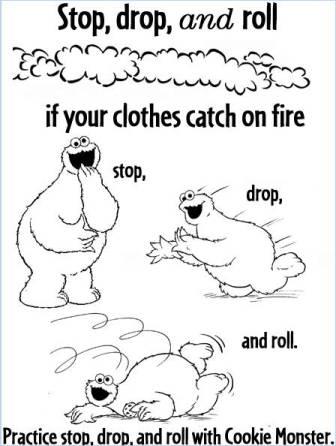
|
Back to top
|